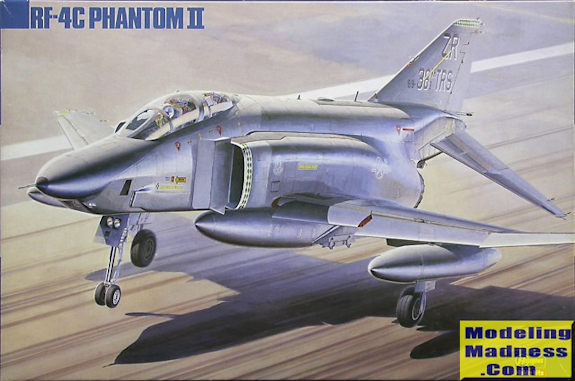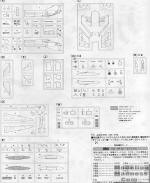
Hasegawa 1/72 RF-4C Phantom II
| KIT #: | 04110 |
| PRICE: | 1800 yen SRP |
| DECALS: | Three options |
| REVIEWER: | Scott Van Aken |
| NOTES: | 1991 base boxing |

| HISTORY |
In the early 1960s, the USAF recognized the need for more tactical reconnaissance aircraft to reinforce the RF-101s then in service. Realizing that the Navy had developed the best production fighter in the world and that speed was necessary for a good tactical reconnaissance plane, the USAF chose a modification of the F-4C fighter (itself a mildly modified Navy F-4B). The RF-4C development program began in 1962, and the first production aircraft made its initial flight on May 18, 1964. The Air Force officially accepted a total of 499 RF-4Cs.
The RF-4C could carry a variety of cameras in three different stations in its nose section. It could take photos at both high and low altitude, day or night. The RF-4C carried no offensive armament, although during the last few years of its service some were fitted with four AIM-9 Sidewinder missiles for defense. The aircraft was also not modified with any of the upgraded wing and stabilizer bits as maneuvering was not considered a desirable feature.
The 16th Tactical Reconnaissance Squadron became the first operational unit to fly the RF-4C. In October 1965 that unit deployed to Southeast Asia to provide photographic reconnaissance of the growing conflict in South Vietnam. In the following years, RF-4Cs flew reconnaissance missions around the world, including Desert Shield/Desert Storm in Iraq in 1990-1991. The Air Force retired all of its RF-4Cs by 1995.
| THE KIT |
 For 1/72 Phantom scale modelers, the Hasegawa kit is still the benchmark. There is always hope that a new tool Phantom will come from someone, but realistically, other than the cockpit and perhaps wheel wells, there is not all that much that can be improved upon. Like all their Phantom kits, this one is a bevy of inserts or alternate parts so that all the variants can be kitted.
For 1/72 Phantom scale modelers, the Hasegawa kit is still the benchmark. There is always hope that a new tool Phantom will come from someone, but realistically, other than the cockpit and perhaps wheel wells, there is not all that much that can be improved upon. Like all their Phantom kits, this one is a bevy of inserts or alternate parts so that all the variants can be kitted.
The cockpit is probably the area that could use the most improvement. Instrument panels and side console instruments are simply decals, though one can go aftermarket with some nice etched brass sets to spruce things up. The seats are five pieces and look like the Martin-Baker seats used though without any harness.
As in many F-4 kits, the area forward of the wings is separate to handle the differences in that area. Since the RF-4B uses the same nose section, the air refueling probe doors will need to be filled. The kit does provide something to put in the camera bay, though it is basically just a shape. Unless actually going on a mission, the cameras were left out so if just putting in some hours or sitting on the ramp, that area would be empty. Both the earlier square and later later lower nose section is provided. Take note of the box art or photos of the real plane to determine which upper fuselage antennas to use. The small addendum sheet included with this kit only relates to the markings and not any bits used in the build.
This aircraft also used the F-15 style of centerline tank if it was carried. What was not carried were missile rails. To my knowledge, none of the kit's options should include those. While later RF-4Cs, such as those with the Nevada ANG, were Sidewinder capable, I cannot verify that was the same for the options provided in the kit. The kit does come with the proper USN style wing pylons. These would have carried jamming pods during operations. The kit also includes inserts for the rear Sparrow bays as the RF-4C did not have those present.
Instructions are the norm for Hasegawa kits and include Gunze paint references. The decals are nicely printed, but unfortunately, are old style Hasegawa decals wi th the white areas a light ivory color. However, there isn't much white on this one so it shouldn't be much of an issue. As a side note, I read an auction description that commented the decals had yellowed. Apparently the seller was unaware of the nuances of Hasegawa kit markings. Markings are provided for three planes. First is a Hill Grey II painted plane from the 38th TRS based in Europe. This one has the rounded camera door. In the same scheme but with the more square door is one from the 106 TRS, Alabama ANG. The third option is in the darker Euro One scheme with 15th TRS based at Kadena with the ZZ tail code.
th the white areas a light ivory color. However, there isn't much white on this one so it shouldn't be much of an issue. As a side note, I read an auction description that commented the decals had yellowed. Apparently the seller was unaware of the nuances of Hasegawa kit markings. Markings are provided for three planes. First is a Hill Grey II painted plane from the 38th TRS based in Europe. This one has the rounded camera door. In the same scheme but with the more square door is one from the 106 TRS, Alabama ANG. The third option is in the darker Euro One scheme with 15th TRS based at Kadena with the ZZ tail code.
| CONCLUSIONS |
As with all their Phantom kits, this one is still an excellent build, though perhaps a tad fussy due to all the inserts. If the type is something you wish to model, then by all means pick up this or any other boxing and use aftermarket decals on it. It makes an excellent model for your Phantom collection.
| REFERENCES |
http://en.wikipedia.org/wiki/McDonnell_Douglas_F-4_Phantom_II November 2016 Copyright ModelingMadness.com. All rights reserved. Thanks to me for the preview kit. If you would like your product reviewed fairly and fairly quickly, please contactthe editor or see other details in the